Mardonius
Mardonius (Old Persian Marduniya): name of several Persian noblemen, a.o. the commander of the Persian troops during two expeditions to Greece (492 and 480/479 BCE).
Youth
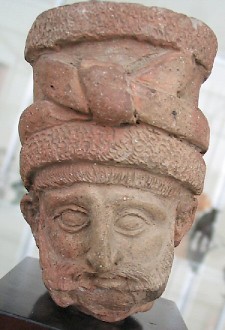
Mardonius was the son of Gobryas,note a Persian nobleman who had assisted the Achaemenid prince Darius when he claimed the throne. Darius, Gobryas and five others had killed the Magian who had usurped the throne, Gaumâta, on September 29, 522 BCE. As usual, the alliance between the new king and his friend was cemented by diplomatic marriages: Darius married Gobryas' daughter,note and Gobryas married Darius' sister.note That Mardonius was the last-mentioned couple's firstborn son is very likely, because he has the same name as Gobryas' father (which is known from the Behistun inscription).
From a cuneiform tablet known as Persepolis Fortification tablet 684, we know that Mardonius was married to a woman named Ardušnamuya. This text was written in March 495, which offers a terminus ante quem for the wedding ceremony. This contradicts the words of the Greek researcher Herodotus of Halicarnassus, who states that Mardonius was still "being a young man and recently married to Artozostre, a daughter of king Darius" in 492.note On the other hand, there is no reason to doubt Herodotus' words that Artozostre/Ardušnamuya was the daughter of Darius and his beloved wife Artystone.
Ionia
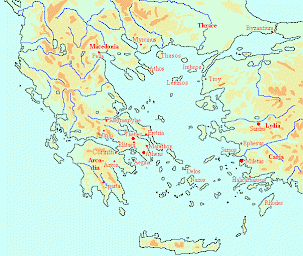
As special representative of king Darius the Great, Mardonius was sent to Lydia (western Turkey) after the revolt of the Ionian Greeks (499-494). He had to reorganize the region, and did so in a very moderate way.
Mardonius sailed along the coast of Asia and came to Ionia. I shall now relate a thing that will be a great marvel to the Greeks: Mardonius deposed all the sole rulers of the Ionians and established democracies in the cities.note
Having reorganized Ionia, Mardonius' navy made for the Hellespont, where it was joined by an army.note The navy may have counted 300 ships, the army 20,000 men. Their first victim was Thasos, a Greek island that possessed important mines. It became a tributary of the Achaemenid Empire.note The navy and the army continued to Macedonia, which was added to Darius' kingdom as well.note During this campaign (which was interpreted by Herodotus as directed against Eretria and Athens) Mardonius lost many ships, as it was caught in a violent northern gale when it tried to round the Athos promontory.note This probably happened on their way back to Asia.
Mardonius had been very successful. There are indications that his army reached the Danube, because an Old Persian inscription was discovered near Gherla in Romania. (The possibility that the inscription was brought to Romania from its original site, however, cannot be ruled out. It may also be a fake.) The conquest of Macedonia was important, as it was a fine base for further conquests in Europe and posessed gold mines. Darius was fully entitled to claim in his inscription at Naqš-i Rustam that he had conquered the Yaunâ takabarâ, the "Greeks with sun hats", a reference to the Macedonian headwear.
First Campaign to Greece
In 490, the Persians conquered the islands in the Aegean Sea, but Mardonius, who had already lost a fleet, was not in charge of this expedition. The 600 ships were commanded by Datis and Artaphernes.note Herodotus again presents the expedition as a punitive action against Eretria and Athens, who had supported the Ionian revolt.note But he is almost certainly wrong, because the army was too small to attack Athens. In reality, the aims of the expedition of Datis and Artaphernes were to add the Aegean island Naxos to the empire,note and, in doing so, to create a buffer zone between Ionia and the Greek mainland. They also had to conquer Euboea (with its capital Eretria) and bring back the former ruler of Athens, the pro-Persian tyrant Hippias. The expedition succeeded brilliantly: Naxos was captured and Eretria fell as well.note Except for their last objective, everything went according to plan.
Having conquered Macedonia and the Aegean islands, Darius could attack the Greek mainland whenever he wanted to. This would be a difficult expedition because the Greek soldiers were better equipped than the Persians and their subjects. Therefore, the Persians had to muster a very large army, but king Darius the Great died shortly before it was to set out (November 486). He was succeeded by his son Xerxes, Mardonius' cousin and brother-in-law.
Xerxes in Greece
According to Herodotus, Mardonius was a zealous advocate of the Greek expedition,note but it was postponed because of a rebellion in Egypt. A second revolt took place in Babylonia, but it did not last very long; the Persian commander Megabyzus was able to terminate the reign of the rebel kings Bêl-šimânni and Šamaš-eriba in the summer of 484. Immediately after this revolt, Xerxes, Mardonius, Megabyzus and four other commanders could go to the west, where a large army was gathering in Sardes.{Herodotus, Histories 7.32.}}
The first year of the expedition was a big success. The Persians were not in a hurry, because they had an enormous army (about 600,000 men?) and had to wait for the harvest in Thrace and Macedonia. In July and August, they stayed at Therma (Thessaloniki), and then moved south to Greece.note Thessaly was conquered without much troubles, and on 17, 18 and 19 September (or one day later) a double battle took place. The Persian navy was able to drive the Greek navy away from its positions at Artemisium, and the army destroyed the Greek garrison at Thermopylae. Boeotia was added to the Achaemenid Empire, and on September 27, Athens was captured;note next day, the acropolis fell and the Persian navy ocuupied the Athenian harbor.
Xerxes' victory was almost complete. The Greek navy had fled to Salamis, an island opposite the harbor of Athens, separated from the mainland by a narrow strait. Unfortunately, when a part of the Persian navy tried to attack the Greek positions on Salamis, they suffered heavy losses.
It was a minor setback. Xerxes had won a naval victory off Artemisium and had won a battle at Thermopylae. He had added Thessaly and Boeotia to the Achaemenid Empire and had taken Athens. In spite of the losses at Salamis, Xerxes, could truthfully state in the Daiva inscription that, by the favor of Ahuramazda, he ruled 'all the Greeks, those who dwell on this side of the sea and those who dwell across the sea.'
Mardonius in Greece
After his victory, Xerxes decided to return to Sardes.note Meanwhile, Mardonius was left in charge of the Persian army in Greece. His army was comparatively small, probably 150,000 men.
To feed his men, he had to retire to Thessaly,note from where he opened negotiations with Athens.note He offered the town a beautiful position in the Achaemenid Empire if only they recognized the overlordship of king Xerxes. It was a brilliant move, because if the Athenians accepted this offer, there was no navy to protect southern Greece anymore. The Athenians had much to gain from the deal, because they would become the most important city state in Greece. However, they stubbornly refused.
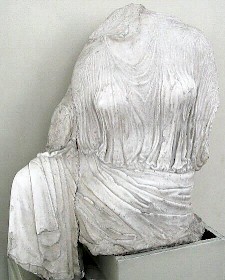
In the spring, Mardonius marched to the south again, reoccupying Boeotia and moving to Athens.note He hoped that the Athenians would be more forthcoming, but he was wrong. Having received a new refusal to surrender, Mardonius plundered Athens.note (Archaeologists digging in Persepolis have discovered a statue of Penelope that was probably taken away from Greece.)
It seemed that Mardonius was master of the situation. The Spartans, who had the best infantry of Greece, refused to assist the Athenians. It was only after an ultimatum by the Athenians that if they did not come to their help, they would be forced to surrender and give their navy to Mardonius, that Sparta acted. It sent an army to the north and invited all Greeks to join in the struggle for the liberation of Greece.note
Plataea
The Greeks gathered in the south of Boeotia, on the foothills of the Kithaeron mountain range.note There were some 100,000 soldiers; almost every Greek able to carry weapons had come Boeotia.note For example, the Athenians had manned only a few galleys; all rowers and marines were now on Mount Kithaeron. This Greek army was unable to move into the plain, because they could not afford to go far beyond the sources at the foothills. After all, August can be very hot in Greece. Since no side dared to advance, a war of nerves started.
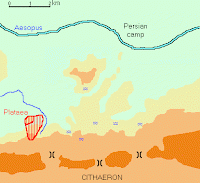
Herodotus, who is our main source for the battle of Plataea, describes several engagements that take place on several days. A Persian cavalry squadron tried to provoke the Greek contingent from Megara, but was defeated.note After this success, the Greeks decided to leave the mountains and to descend into the plain between the river Asopus and a small town called Plataea,note where a large source in the middle of the plain (near the hill in the middle of the map) would refresh them. All this time, the two armies refrained from real attacks, because they received the same omens: they would only be victorious when the other side attacked first (and moved away from its water supply).note
However, Mardonius was in a hurry. His supplies were running out, he could see the Greek army growing every day and one of his advisors has already suggested to return to Thessaly and use gold and silver to bribe the Greek leaders. Mardonius would have none of it: he still hoped to settle the matter with honorable, military means.
To stop the growth of the other army, he unexpectedly and successfully attacked a large supply train in the Kithaeron.note Short cavalry charges, meant to provoke his enemies into battle, were executed, but the Greeks wisely resisted the temptation.
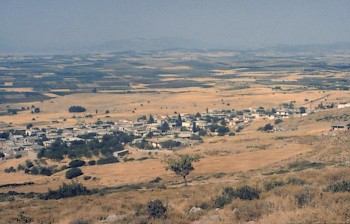
Herodotus tells that one night, a Persian ally, the Macedonian king Alexander, came to visit the Athenians, telling them that the Persians would attack at dawn.note Immediately, the Athenian officers informed the supreme commander of the Greeks, the Spartan prince Pausanias. He understood that if the Persians attacked, it would be saver to have the well trained Spartans on the defensive left wing to counter the Persian main force, and to post the experienced Athenians - already victorious at Marathon - on the offensive right wing. At dawn, the two contingents changed positions. After reports of a Persian counter-manoeuvre, the two Greek contingents return to their original positions.
So far Herodotus. He seems to have misunderstood the incident. It is implausible that Alexander of Macedonia could leave the Persian camp without being seen. It is likelier that Mardonius sent the Macedonian king on his mission. It was a brilliant trick to create panic among the Greeks, who started all kinds of exhausting movements.
In this way, the day passed without fighting, and Mardonius became even more anxious to attack. During the night, his mounted archers attacked the source between Plataea and the Asopus,note hoping to force the Greek troops to go back to the south, to the sources on the slopes of the Kithaeron mountains. They stood their ground during the day - being continually harassed by the Persian archers - but after sunset, they retreated as Mardonius had planned.note
At dawn, Mardonius learned that his opponents had fled,note and thinking he had already won the battle, ordered the pursuit of the Greeks.note He first attacked the Spartans, who were forced back.note Pausanias even had to sent a messenger to ask the Athenians for help,note but they were unable to offer assistance, because they were intercepted by Mardonius' Greek allies.note One of the Persian contingents even broke through the Greek battle array and reached the foothills of the Kithaeron.note
At this moment, while he was pursuing the retiring Spartans, Mardonius was killed.note It is not known how this happened, but we can be sure that Mardonius, who knew that his army had been victorious, died as a happy man.
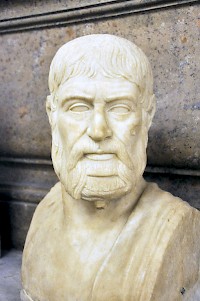
This incident changed the battle, because the Persians lost courage, which gave the Spartans an opportunity to attack the Persian contingent in front of them.note The struggle did not last long: the demoralized Persians took their heels. The Persian camp was captured by the Athenians,note and that meant the end of the war. One of Mardonius subordinates, Artabazus, was able to lead a large Persian contingent back to Asia, for which he was rewarded by Xerxes, who offered him the satrapy of Hellespontine Phrygia, i.e., the northwest of what is now Turkey.
The engagement at Plataea took place in the summer of 479, perhaps in the week of August 15. Herodotus has a very strange story to tell about an event that took place after the battle.
The body of Mardonius however had disappeared on the day after the battle [...] I have heard the names of many men of various cities who are said to have buried Mardonius, and I know that many received gifts from Artontes, the son of Mardonius, for having done this.note
To the Greek audience of Herodotus, this made perfect sense, but a Persian would be shocked to hear this. It was not their custom to bury the dead. Zoroastrians preferred to have their bodies exposed to the vultures.